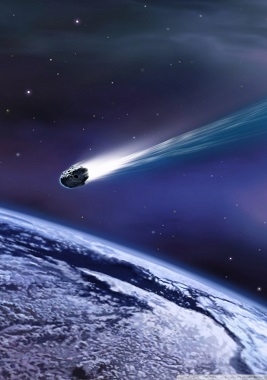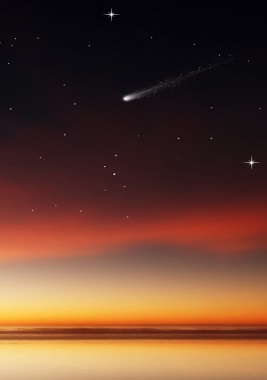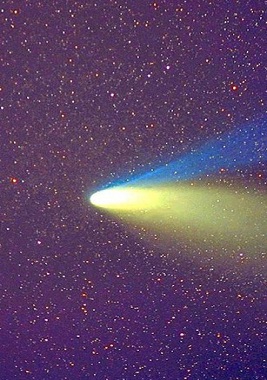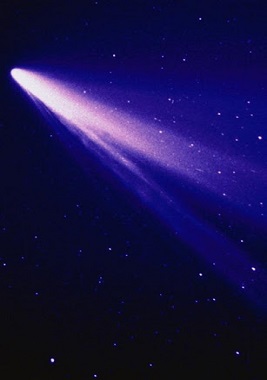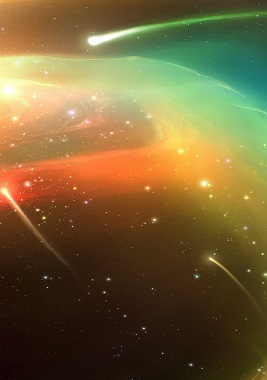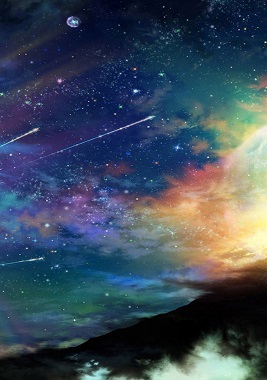Comets
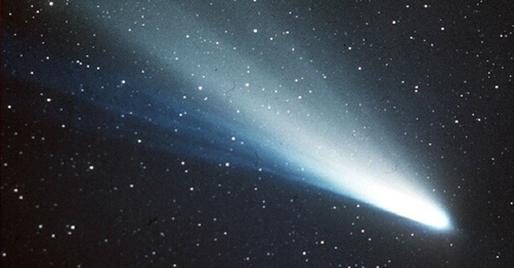 Comets are small and icy bodies that heat up upon approaching the sun to form its coma and tail, symbolizing its status as a comet. The coma is the surrounding shell of light that is seen often congregating around the main body of the comet which is composed of ice and dust. The effect itself is created through the outgas of the internal gases heating up and being released from the comet's inner core due to the Sun's light pressure or the solar winds. This coma even extends further through the path of the comet, leaving behind the tail which is just a trail of dust and gas from the coma. This effect is usally bright enough to see without any telescope or sight-magnifying tool. Because of their differing size and amount of gas within themselves, comets often have a wide range of orbital periods, or the time it takes for one body to orbit another, expanding from several years to millions of years. The short-range comets are thought to have come from the Kuiper Belt, around the orbit of Neptune; long-range comets are thought to be coming from the Oort Cloud, a spherical cloud of icy bodies, located outside the Kuiper Belt to halfway across the next stars. The main difference between comets and asteroids is the existance of the coma around the comet's body; however, when the gas within the comet runs out, comets can become extinct and begin to resemble smaller asteroids. As of November 2014, there are only 5,253 known comets that have been seen from Earth. Some of the more famous comets include the Hale-Bopp comet and even more so in America is the Halley Comet, which creates the Oroionid meteor shower every time it is seen.
Comets are small and icy bodies that heat up upon approaching the sun to form its coma and tail, symbolizing its status as a comet. The coma is the surrounding shell of light that is seen often congregating around the main body of the comet which is composed of ice and dust. The effect itself is created through the outgas of the internal gases heating up and being released from the comet's inner core due to the Sun's light pressure or the solar winds. This coma even extends further through the path of the comet, leaving behind the tail which is just a trail of dust and gas from the coma. This effect is usally bright enough to see without any telescope or sight-magnifying tool. Because of their differing size and amount of gas within themselves, comets often have a wide range of orbital periods, or the time it takes for one body to orbit another, expanding from several years to millions of years. The short-range comets are thought to have come from the Kuiper Belt, around the orbit of Neptune; long-range comets are thought to be coming from the Oort Cloud, a spherical cloud of icy bodies, located outside the Kuiper Belt to halfway across the next stars. The main difference between comets and asteroids is the existance of the coma around the comet's body; however, when the gas within the comet runs out, comets can become extinct and begin to resemble smaller asteroids. As of November 2014, there are only 5,253 known comets that have been seen from Earth. Some of the more famous comets include the Hale-Bopp comet and even more so in America is the Halley Comet, which creates the Oroionid meteor shower every time it is seen.
Asteroids
 Asteroids are essentially larger scale comets without the signature coma and tail patterns from the comets. Most asteroids would be considered to be minor planets within our Solar System, and even larger ones could be considered to be planetoids, or small celestial bodies which orbit the sun. Asteroids can only be considered to be asteroids if and only if they orbit the sun, do not exhibit a disc of a planet, and do not have the characteristics of an active comet, which is the coma and the tail. Many asteroids are thought to be debris from planetisimals, often resting between the asteroid belts between Mars and Jupiter. All of the said asteroids can be divided into three distinct categories: C-type, S-type, and M-type. The C-type is associated with being carbon-rich, often making the structure of the asteroid more rubble than anything else loosely held together. The S-type represents the stony type of asteroids, often being just one mass collectively instead of a collection of rocks; and the M-type is the metallic type of asteroids, filled more with metal and harder substances than rock.
Asteroids are essentially larger scale comets without the signature coma and tail patterns from the comets. Most asteroids would be considered to be minor planets within our Solar System, and even larger ones could be considered to be planetoids, or small celestial bodies which orbit the sun. Asteroids can only be considered to be asteroids if and only if they orbit the sun, do not exhibit a disc of a planet, and do not have the characteristics of an active comet, which is the coma and the tail. Many asteroids are thought to be debris from planetisimals, often resting between the asteroid belts between Mars and Jupiter. All of the said asteroids can be divided into three distinct categories: C-type, S-type, and M-type. The C-type is associated with being carbon-rich, often making the structure of the asteroid more rubble than anything else loosely held together. The S-type represents the stony type of asteroids, often being just one mass collectively instead of a collection of rocks; and the M-type is the metallic type of asteroids, filled more with metal and harder substances than rock.
Meteors
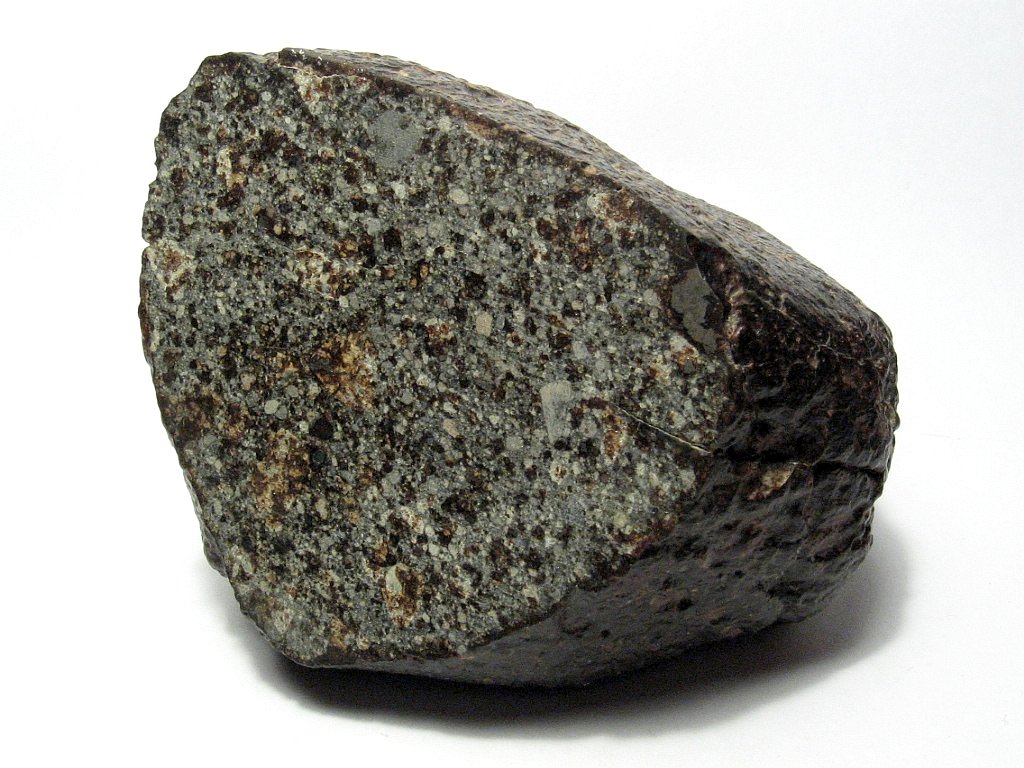 Meteors are the short, white trails across the sky that we call "shooting stars." They are caused by small pea-sized pieces of inter-planetary dust that burn up when they slam into the Earth's atmosphere at high speeds. Sometimes meteor showers happen because micro-sized particles fall off from comets and enter the gravity of Earth and streak across the sky. Sometimes, meteors will go through the surface and create fireballs, which are often very bright and fast as they fall through the atmosphere. While similar to comets, these fireballs will be visible for a few minutes, while comets are often able to be seen for a few days at most. When the fireballs are not completely vaporized and hit the surface of the Earth, they become meteorites.
Meteors are the short, white trails across the sky that we call "shooting stars." They are caused by small pea-sized pieces of inter-planetary dust that burn up when they slam into the Earth's atmosphere at high speeds. Sometimes meteor showers happen because micro-sized particles fall off from comets and enter the gravity of Earth and streak across the sky. Sometimes, meteors will go through the surface and create fireballs, which are often very bright and fast as they fall through the atmosphere. While similar to comets, these fireballs will be visible for a few minutes, while comets are often able to be seen for a few days at most. When the fireballs are not completely vaporized and hit the surface of the Earth, they become meteorites.
Sources
